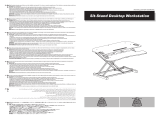
vi Contents
5.8.2 Outboard Expansion Board.................................................................5-11
5.9 System Board Components.............................................................................5-12
5.9.1 Memory Modules................................................................................5-12
5.9.2 System Board Graphics Memory Module Upgrade............................5-13
5.9.3 Microprocessor....................................................................................5-14
5.9.4 Cache Memory (Pentium System Only) .............................................5-17
5.10 Riser Board .....................................................................................................5-18
5.11 Riser Brace......................................................................................................5-19
5.12 Expansion Board Guide ..................................................................................5-20
5.13 Replacement Battery.......................................................................................5-21
5.14 Front Bezel Assembly.....................................................................................5-23
5.14.1 Front Bezel.........................................................................................5-23
5.14.2 Power Button......................................................................................5-24
5.14.3 Bezel Blank........................................................................................5-25
5.14.4 Compaq Logo.....................................................................................5-26
5.15 Power Supply Assembly.................................................................................5-27
5.15.1 Power Switch Assembly.....................................................................5-27
5.15.2 Power Supply .....................................................................................5-29
5.16 Mass Storage Devices.....................................................................................5-30
5.16.1 3.5-Inch Drive Bays ...........................................................................5-30
5.16.2 5.25-Inch Drive Bays .........................................................................5-32
5.16.3 Installing a New Drive .......................................................................5-34
5.17 Drive Cage ......................................................................................................5-37
5.18 LED Cable.......................................................................................................5-38
5.19 System Board..................................................................................................5-40
chapter 6
Removal and Replacement Procedures - Minitower
6.1 Serial Number ...................................................................................................6-1
6.2 Disassembly Sequence Chart ............................................................................6-2
6.3 Preparation for Disassembly .............................................................................6-3
6.4 Feet....................................................................................................................6-3
6.5 Cable Lock ........................................................................................................6-4
6.6 Exposing the Chassis.........................................................................................6-5
6.6.1 Access Panel.........................................................................................6-5
6.6.2 Minitower J Hood.................................................................................6-6
6.7 Riser Brace........................................................................................................6-7
6.8 Expansion Board...............................................................................................6-8
6.9 Expansion Board Guide ..................................................................................6-10
6.10 Riser Board .....................................................................................................6-11
6.11 Speaker............................................................................................................6-12
6.12 System Board Components.............................................................................6-13
6.12.1 Memory Module.................................................................................6-13
6.12.2 Microprocessor...................................................................................6-14
6.12.3 Cache Memory (Pentium System Only) ............................................6-17
6.12.4 System Board Graphics Memory Module Upgrade...........................6-18
6.13 System Board..................................................................................................6-19
6.14 Replacement Battery.......................................................................................6-22
6.15 ISA Option Board Retainer.............................................................................6-24























